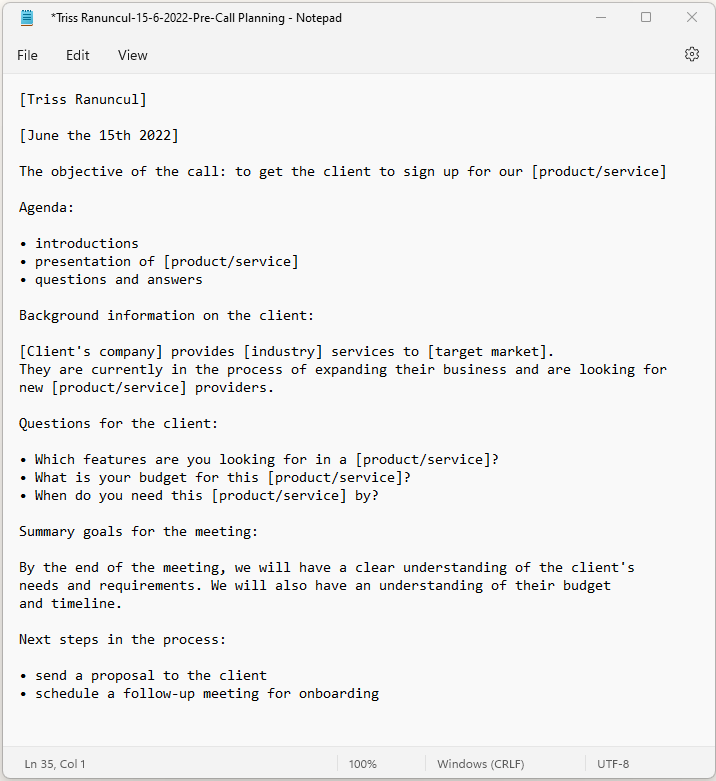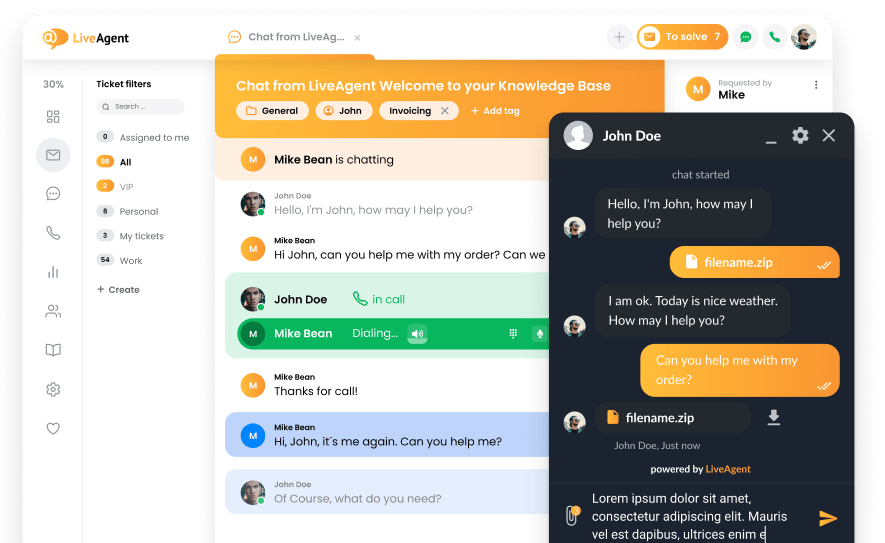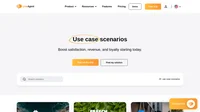- Email Templates
- Pre-call planning template
Pre-call planning template
Improve your client meetings with LiveAgent's pre-call planning templates. Enhance productivity, address objections, and save time using these structured guides for notes, agendas, and client insights. Try LiveAgent's CRM and universal inbox for efficient sales pitches.

Feeling unprepared for your client meetings? If so, you’re not alone.
Many business owners don’t take the time to properly prepare for their meetings, which can lead to a lot of wasted time and energy.
Today, we will discuss how to best plan for your prospective client meetings so you’ll be able to get the most out of each one.
The importance of pre-call planning
By taking the time to properly prepare for your meetings, you’ll be able to make each one as productive and efficient as possible. Pre-call planning allows you to build better relationships with your clients as you will have a better understanding of their needs.
With pre-call planning, you can identify any potential objections that your clients may have and address them before the meeting. Even though pre-call planning may take some extra time upfront, it will save you time in the long run by eliminating unproductive meetings.
How to title a pre-call planning email
When you’re pre-call planning, it’s important to have a clear and concise note-taking system. One way to do this is by titling your notes with the date and time of the meeting, as well as the name of the client. This will help you to keep track of your meeting notes and get you prepared for each meeting.

You will likely have to filter through many templates associated with various clients or projects, so titling your notes with the date can help you to quickly identify which ones are associated with each meeting.
And, since you’re sending them out to your team, colleagues, sales team, or even just yourself, it would be beneficial to have the meeting title in the subject line of the notes so everyone can easily find them afterward.
Pre-call planning email subject line examples
- Prospective Client Meeting – [Client’s Name] [Date of Call]
- Pre-Meeting Planning – [Date of Call] [Client’s Name]
- [Client’s Name] [Date of Call] | Pre-Call Planning
- Pre-Call Planning [Client’s Name] [Date of Call]
- Prospective Meeting with [Client’s Name] [Date of Call]
- Planning Stage [Client’s Name] [Date of Call]
- Plan Of Action [Client’s Name] [Date of Call]
- [Client’s Name] [Date of Call] – Pre-Meeting Discussion
How to write a pre-call planning template
Pre-call planning doesn’t have to be complicated. In fact, it can be as simple as creating a list of key questions that you want to ask your clients. By having one you’ll be able to ensure that each meeting is focused and productive.
Start with the purpose of the call. What are you hoping to accomplish and how to do it? This will allow you to identify the main objectives of the call and focus every question on achieving these objectives.
Create an agenda. What topics do you want to discuss during the call and why? This will help to keep the meeting on track and prevent you from getting sidetracked by other topics.

Prepare some background information on the client. This can include anything from their company history to their current projects. You should also list questions that your potential client may have. By having this information, you’ll be able to better understand their needs and how you can assist them.
Make a list of questions that you want to ask the client, which could be anything from clarifying their needs to understanding their budget. This will contribute to keeping the meeting focused and productive.
Finally, set up summary goals for the meeting. What do you hope to achieve by the end of the call? This will allow you to measure the success of the meeting, as well as identify the next steps in the process.
What to include in a pre-call planning template
- purpose of the call
- agenda
- background information on the client
- questions for the client
- summary goals for the meeting
- next steps in the process
Pre-call planning templates and examples
Prospective Client Meeting – [Client’s Name] [Date of Call]
[Client’s Name]
[Date of Call]
The objective of the call: to discuss the possibility of working together on [Project Name].
Agenda:
• introductions
• discuss project scope
• questions and answers
Background information on the client:
[Client’s company] is a [company size] company that specializes in [industry]. They are currently working on a [project type] project called [Project Name].
Questions for the client:
• What is your budget for this project?
• What is the timeline for this project?
• What are your objectives for this project?
Summary goals for the meeting:
By the end of the meeting, we will have a clear understanding of the project scope and objectives. We will also have an understanding of the client’s budget and timeline.
Next steps in the process:
• send a proposal to the client
• schedule a follow-up meeting to discuss the proposal
Pre-Meeting Planning – [Date of Call] [Client’s Name]
[Date of Call]
[Client’s Name]
The objective of the call: new arrangements for [project]
Agenda:
• introductions
• current situation
• questions and answers
Background information on the client:
[Company name] has been our client for [time period]. They are currently working on a [project type] project and would like to change the [project details].
Questions for the client:
• How should we proceed with the changes?
• Which team members should be involved in the project?
• What is the timeline for the project?
Summary goals for the meeting:
By the end of the meeting, we will have a clear understanding of how to proceed with the changes and which team members should be involved. We will also have an understanding of the timeline for the project.
[Client’s Name] [Date of Call] | Pre-Call Planning
[Client’s Name]
[Date of Call]
The objective of the call: to get the client to sign up for our [product/service]
Agenda:
• introductions
• presentation of [product/service]
• questions and answers
Background information on the client:
[Client’s company] provides [industry] services to [target market]. They are currently in the process of expanding their business and are looking for new [product/service] providers.
Questions for the client:
• Which features are you looking for in a [product/service]?
• What is your budget for this [product/service]?
• When do you need this [product/service] by?
Summary goals for the meeting:
By the end of the meeting, we will have a clear understanding of the client’s needs and requirements. We will also have an understanding of their budget and timeline.
Next steps in the process:
• send a proposal to the client
• schedule a follow-up meeting for onboarding
[Client’s Name] [Date of Call] – Pre-Meeting Discussion
[Client’s Name]
[Date of Call]
The objective of the call: discuss possible solutions for [existing project]
Agenda:
• introductions
• current situation
• questions and answers
Background information on the client:
[Client’s company] delivers [industry] services to [target market]. They are currently working on a project called [Project Name] and are facing some challenges. They were a client of ours previously, and we successfully completed a project called [Past Project Name].
Questions for the client:
• What are the challenges you are facing with the current project?
• Do you have a budget for the new project?
• Which team members are working on this project?
Summary goals for the meeting:
By the end of the meeting, we should get a clear understanding of the challenges the client is facing in sending a proposal. We will also know about the client’s budget and timeline.
Next steps in the process:
• sorting out the renewal of the collaboration
• gathering more information about the project during the debrief
Pre-Call Planning [Client’s Name] [Date of Call]
[Client’s Name]
[Date of Call]
The objective of the call: to provide a proposal for [Project Name]
Agenda:
• introductions
• presentation of proposal
• questions and answers
Background information on the client:
[Client’s company] is a leader in the [industry] industry. They have been our client for [X] months/years, and are thinking of upgrading their [product/service].
Questions for the client:
• What are your thoughts on the proposal?
• Do you have any questions about the proposal?
• When would you like to start the project?
Summary goals for the meeting:
By the end of the meeting, we should have a few more details established about the project. We will know when they would like to start and have an idea about their thoughts on the proposal.
Next steps in the process:
• send a contract to the client
• schedule a meeting for signing the contract
Prospective Meeting with [Client’s Name] [Date of Call]
[Client’s Name]
[Date of Call]
The objective of the call: to sign the contract for [Project Name]
Agenda:
• introductions
• review of the contract
• questions and answers
Background information on the client:
[Client’s company] is a leader in the sector of [industry]. They have been our client for [time period], and we have completed a few projects together during that time. The most recent one was called [Project Name].
Questions for the client:
• Do you have any questions about the contract?
• When would you like to start the project?
Summary goals for the meeting:
By the end of the meeting, we will have a signed contract for the project. We should also know when they would like to start the project.
Next steps in the process:
• send a welcome pack to the client
• schedule a kickoff meeting with the client’s team
• send an email to the team with background information
Planning Stage [Client’s Name] [Date of Call]
[Client’s Name]
[Date of Call]
The objective of the call: to kick off [Project Name]
Agenda:
• introductions
• review of project goals
• questions and answers
Background information on the client:
[Client’s company] is a leader in their industry, with a focus on [target market]. They have been our client for a few years, and we have completed several different projects together.
Questions for the client:
• How could we improve our collaboration?
• Do you have any questions about the project goals?
Summary goals for the meeting:
By the end of the meeting, we should have a clear understanding of the client’s expectations. We will also know what their thoughts are on how we can improve our collaboration.
Next steps in the process:
• send a thank you email to the client
• schedule regular check-in calls with the client’s team
• begin work on the project deliverables
Pre-Call Planning Template – Good practices
In terms of pre-call sales planning, there are a few key things you should always do before hopping on a call with a prospective client. This includes:
- Reviewing the client’s website – can give you a lot of info on their business, their target market, etc. It is an absolute must-do when it comes to pre-call planning.
- Verifying their social media profiles – tells you about their tone of voice and what kind of content they share, etc.
- Reviewing the proposal – clarify what you’re offering and what the client is looking for.
- Checking in with your team – ask if anyone else has spoken to the client recently and if they have any insights on actual sales conversations.
- Having an understanding of the client’s budget and timeline – for tailoring the conversation, coming up with a realistic proposal, and setting expectations.
- Preparing questions for the client – to get the most out of the call, list a few things that you want to ask beforehand.
- Gathering background information on their company – to build rapport and show that you’re invested in their business.
- Learning about their industry and target market – the more you know, the more valuable you can be to them and impactful on their buying decision.
- Writing a list of questions that you may be asked by the client – sales agents need to be prepared for anything, as the client may have concerns about your proposal.
- Asking for referrals – this is a great way to grow your company and get more clients, but also acts as social proof for your business.
- Developing a sales pre-call plan of action for the meeting – you need to have clear and firm goals in mind for the call, as well as know what you want to achieve.
- Creating a follow-up plan – after the call, you should have an idea about what to do next. It could be sending a proposal, scheduling another meeting, or just staying in touch.
- Sending a “thank you” note after the call – show gratitude to your prospect for their time and send them a recap of what was discussed. If you have any additional information that they may find useful, be sure to attach it too.

Summary
Pre-call planning is an essential part of the sales process that can help you get the most out of your prospective client meetings. By taking the time to research your prospects, understand their needs, and develop a solid plan for the meeting. You will increase your chances of making a successful sale.
Jumpstart your phone sales with LiveAgent!
Start your free 30-day trial and improve your sales pitches with our ticketing and cloud-call center features.
Frequently Asked Questions
How does pre-call planning work?
The goal is to prepare for sales meetings with prospective clients. This includes researching the client, their needs, and the industry they operate in. Pre-call planning also involves developing a whole sales call strategy with relevant questions and other activities supporting sales efforts, all for efficient sales calls and overall business activities.
Why is pre-call planning crucial for business?
You will be better prepared to sell your products or services. This is because, during your sales conversation, you will have a better understanding of the client’s needs and how you can help solve them. Additionally, pre-call planning allows you to build rapport with the prospect and establish trust.
How do I start pre-call planning?
Before hopping on a call with a prospective client, each sales professional should create a sales plan including what kinds of questions to ask and what conversation starters should work best. Be sure to review your proposal and have a clear understanding of the client’s budget and timeline. Finally, develop an irresistible sales pitch.
What makes pre-call planning successful?
There are a few key components: make sure sales reps are clear on the purpose of the meeting and what they hope to achieve. Do your research ahead of time so that you can be prepared for anything that comes up in the buying process, and follow up with the client after the meeting to thank them for their time. Send them any additional information they may find helpful, and ask any key questions that weren’t addressed during the sales call.
Should you add attachments to pre-call planning templates?
You can, but it’s not necessary. If you have any additional information that would be helpful for the meeting or the entire sales strategy, feel free to include it in your template. However, attachments are not required and can be sent separately if required.
Do pre-call planning templates need to be long?
No, pre-call planning templates can be as long or as short as you want. The important thing is that they include all of the necessary information to prepare for a successful meeting. Sometimes, shorter is even better because it can be easier to digest all of the information in your sales cycle.
What are some common pre-call planning mistakes?
One of the most frequent is salespeople not doing enough research on the client. This can lead to coming into the meeting unprepared and not having a clear understanding of their needs. Another mistake is not having a solid plan for what to do after the meeting, which can result in lost opportunities. Prepare some open-ended questions that you can use for your follow-ups to dispel any doubts or common objections.
You will be
in Good Hands!
Join our community of happy clients and provide excellent customer support with LiveAgent.

Our website uses cookies. By continuing we assume your permission to deploy cookies as detailed in our privacy and cookies policy.

 Български
Български  Čeština
Čeština  Dansk
Dansk  Deutsch
Deutsch  Eesti
Eesti  Español
Español  Français
Français  Ελληνικα
Ελληνικα  Hrvatski
Hrvatski  Italiano
Italiano  Latviešu
Latviešu  Lietuviškai
Lietuviškai  Magyar
Magyar  Nederlands
Nederlands  Norsk bokmål
Norsk bokmål  Polski
Polski  Română
Română  Русский
Русский  Slovenčina
Slovenčina  Slovenščina
Slovenščina  简体中文
简体中文  Tagalog
Tagalog  Tiếng Việt
Tiếng Việt  العربية
العربية  Português
Português 



